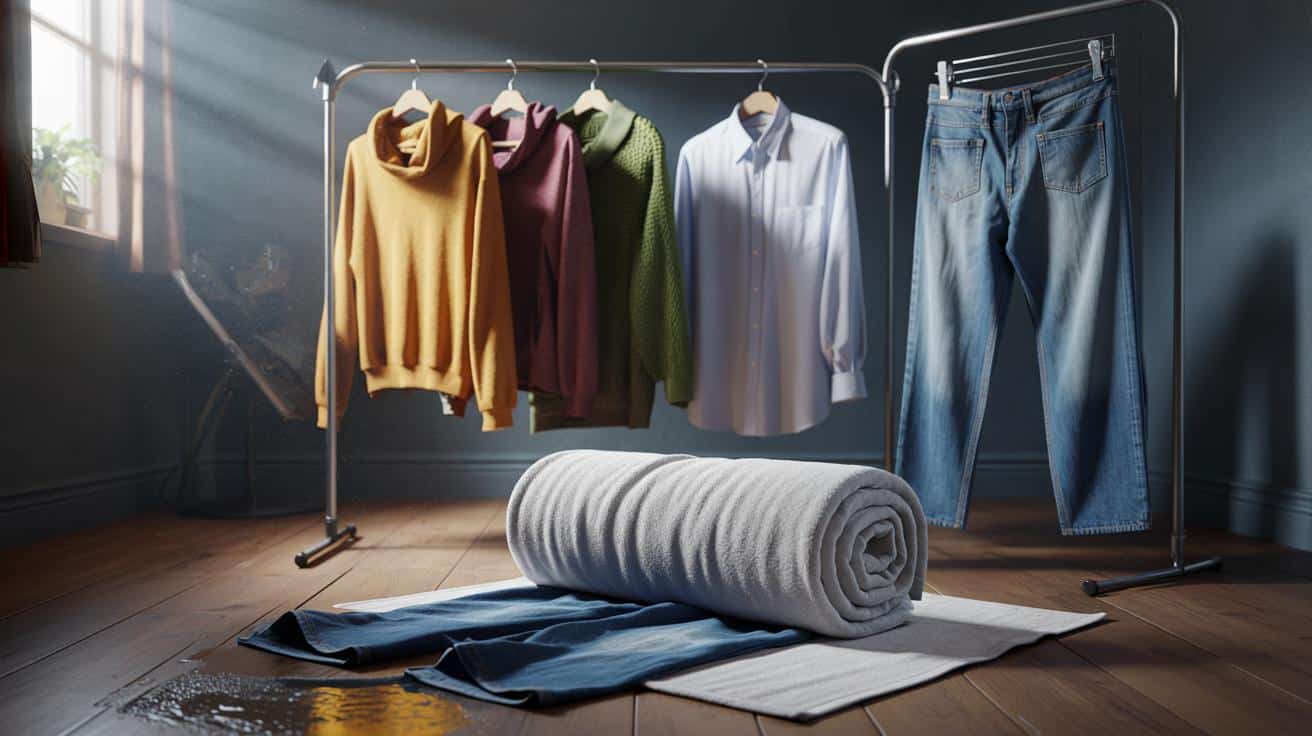A pile of damp jumpers, no budget for the tumble dryer, and a flat that fogs up the moment you breathe — that’s the season. Yet there’s a simple, no-heat way to speed things up using one humble thing you already own. No gadgets. No gimmicks. Just a fresh result.
The window was cracked, but the air still felt tired, the kind that clings to your cheeks and turns curtains into wet sails. *The air felt like a grey sponge.*
The kettle clicked, the radio muttered traffic on the A1, and I kept glancing at that stubborn denim. Then I remembered my gran’s move — not fancy, not expensive, just practical. One household item, a tiny ritual, and suddenly the room didn’t feel like a laundry cave anymore.
I tried it on one pair first, half curious, half sceptical. Five minutes later, the jeans looked different — lighter somehow, less heavy with the day. The water was somewhere else. The trick needs one thing.
Why indoor drying slows to a crawl when the weather turns
Cold rooms don’t hold much moisture, so the water sits in your clothes and refuses to budge. Radiators tempt us, but they turn living rooms into mini rainforests, feeding mould on window frames and making the whole place smell faintly of a gym bag. It’s slow, and it’s quietly costly for your home.
In shared houses and small flats, the story repeats itself. You run a wash in the evening, hang it across the airer, and wake to the same damp cuffs and heavy hems. We’ve all had that moment where you sniff a T‑shirt and wonder if it’s actually dry or just pretending, like a handshake after a swim.
The science is simple and strangely human. Evaporation needs two things: space around fibres and the movement of air. When laundry is dripping-wet, the air can’t do much, no matter how bravely your window cracks open. So the real win comes before hanging — moving water out of the fabric without warmth, so air has less work to do.
The one-item hack that changes the game: a big dry towel
Grab a clean, large bath towel. Lay your wet garment flat on it, smooth it once with your palm, then roll the towel up like a Swiss roll, trapping the fabric inside, edge to edge. Now the moment: stand on the roll, heel to toe, shifting your weight to press water into the towel, or kneel and press along the log with your forearms for 30–60 seconds.
Unroll, give the garment a single, sharp shake, and hang it with space around it — shoulders wide on a hanger for shirts, waistband clipped flat for jeans. Let’s be honest: nobody does this for an entire family wash every single day. Pick the slowpokes of your load — denim, hoodies, thick cotton — and “towel-press” those. You’ll cut their drying time, and the room will feel less steamy.
What’s happening is beautifully low-tech. The towel acts like a thirsty second spin, wicking out the water the machine couldn’t fling. **This frees half the water before the air even starts working.** Your clothes are lighter, your room is drier, and your airer suddenly feels like it upgraded itself.
“Think of the towel like a friendly press officer for your laundry,” laughed Nina, a Leeds mum who dries school uniforms in a two-bed flat. “It gets the big story out fast, then the air just tidies the details.”
- Use a thick towel for bulky items; a hand towel works for tees and small tops.
- Press, don’t twist — you’re nudging water out, not wringing fibres into misery.
- After pressing, leave gaps between items so air can move freely.
- Crack a window for ten minutes to let moisture escape the room.
- Refresh the towel when it feels properly damp; swap for a dry one if needed.
Little tweaks that stack up to big, dry wins
Before you even reach for the towel, spin your wash again on a high-speed cycle. Two extra minutes in the machine beats two extra hours on the rack. Then do the towel press for the heavy bits — jeans, hoodies, thick socks — and hang them where air can actually pass, not bunched up like commuters at 8:45.
Hang by shape, not habit. Shirts go on hangers with the top buttons fastened so fabric spreads; jumpers lie flat on a rack so shoulders don’t sag; jeans clip by the waistband, pockets turned out so trapped moisture can leave. **Tiny positioning changes shave real drying time**, and they feel oddly satisfying.
Use height to your advantage. Warm air sits higher, even in a cool room, so put the thick stuff on the top tier of your airer. Open the door for a cross-breeze, or set a small fan on the floor to push air through the forest of sleeves — low energy, big effect. Soyons honnêtes : personne ne fait vraiment ça tous les jours. Pick one or two habits you’ll actually keep.
A softer take on laundry, and on winter
There’s a shift that happens when the towel trick becomes normal. The room smells fresher, the windows clear faster, and you stop dreading the midweek wash because it no longer takes over your whole life. You’re nudging laundry from stubborn chore to short ritual, and your home responds in kind.
It’s not just about speed. It’s about the feel of living with wet things in a small space — a kinder approach that spares your radiators, keeps mould at bay, and gives you back a bit of calm. Share it with flatmates, teach it to teenagers, keep a “press towel” on standby in the airing cupboard.
One towel. Two minutes. Less damp in your day. The sort of fix that passes from neighbour to neighbour, not because it’s flashy, but because it simply works. And it’s oddly pleasing, watching water choose the towel instead of your Tuesday night.
| Key point | Detail | Interest for readers |
|---|---|---|
| Towel press replaces heat | Roll, press, unroll — removes excess water fast | Lower bills, quicker turnarounds |
| Airflow beats patience | Space items, crack a window, use height | Faster drying without gadgets |
| Shape matters | Hangers for shirts, clips for jeans, flat for knitwear | Better results and fewer musty smells |
FAQ :
- Does the towel trick work on heavy towels and bedding?It helps, but focus on the worst areas. Press the cuffs, waistbands, and corners, then hang with maximum space. For bedding, fold lengthways and press in sections.
- Won’t pressing with my feet damage clothes?No if you press, not stomp. Keep shoes off, distribute weight heel to toe, and avoid delicate fabrics like silk. For those, use forearms and lighter pressure.
- What if I don’t have a big bath towel?Use two medium towels end to end, or repeat with a smaller towel in batches. The goal is thirsty cotton against wet fabric, not the towel’s exact size.
- Is a fan allowed if this is “no heating”?Yes — it’s air movement, not heat. A small fan on low uses little energy and speeds evaporation. Point it so it skims across the airer, not directly into one wet patch.
- Why do my clothes still smell musty sometimes?They likely dried too slowly or too close together. Press them first, space them out, and vent moisture with a brief window-open routine. Wash machine seals and drawers to avoid stale transfer.









